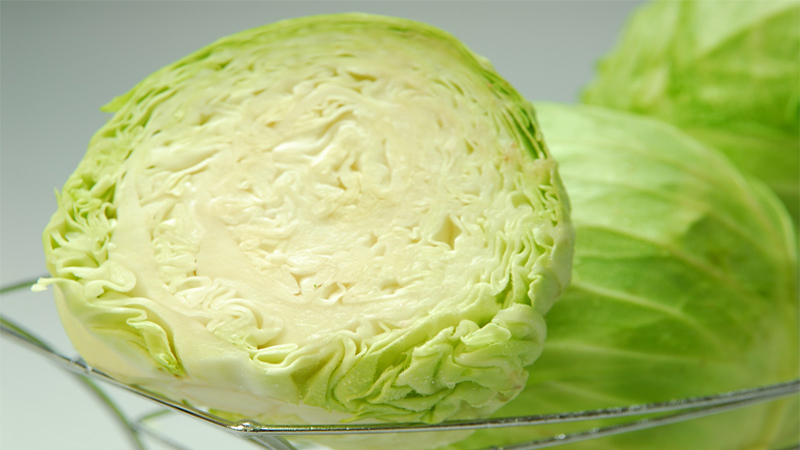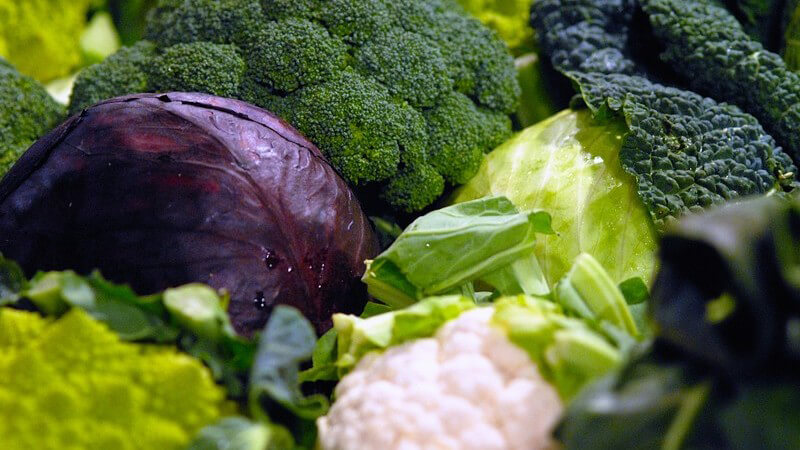How many calories are in fresh cabbage
The popularity of the white cabbage in the diet due to its low calorie content, high fiber content and the benefits of the vegetable. The body spends a lot of energy digesting and assimilating the product, which ensures weight loss. From the article you will learn how many calories are in cabbage, as well as its benefits and harms to the body.
The content of the article
How many calories are in fresh cabbage
Cabbage has been a staple of Northern European cuisine for centuries. The vegetable contains biological active substances, enzymes, pantothenic and folic acids, various organic substances that are necessary for the full functioning of the body.
BJU and calorie content per 100 g of product:
- calorie content - 27 kcal;
- proteins - 1.8 g;
- fats - 0.1 g;
- carbohydrates - 4.7 g.

The chemical composition of cabbage
The vegetable's characteristic flavor comes from glucosinolates, a class of sulfur-containing glucosides - compounds that are responsible for the vegetable's potential health benefits. Although they are found throughout the plant, they are most concentrated in the seeds.
Reference! 3,3'-diindolylmethane is a chemical in cabbage that prevents the negative effects of radiation.
What vitamins are in white cabbage
Cabbage is a source of vitamins C and K. 100 g of the product contains 44% and 72% of the daily value, respectively.
The vegetable is also rich in other vitamins and minerals:
- B6 - 10%,
- B1 - 7%,
- B5 - 4%,
- B2 - 3%,
- B3 - 25%,
- B9 - 11%,
- manganese - 8%,
- calcium - 4%,
- iron - 4%,
- magnesium - 3%,
- phosphorus - 4%,
- potassium - 4%,
- zinc - 2%,
- sodium - 1%.
What else is in cabbage
Cabbage contains antioxidants - choline, beta-carotene, lutein and zeaxanthin - and flavonoids - kaempferol, quercetin and apigenin.
The vegetable is rich in phytochemicals: thiocyanates, indole-3-carbinol, lutein, zeaxanthin, sulforaphane and isothiocyanates.
The amino acids found in the vegetable include:
- alanine (0.6%) - takes part in the production of antibodies;
- arginine (1.2%) - irreplaceable in the elimination of ammonia;
- cystine (0.6%) - is responsible for the normal function of the muscles;
- glutamic acid (2%) - improves mental health, prevents schizophrenia, tones the body;
- leucine (2%) - activates the processes of amino acid biosynthesis;
- tyrosine (0.4%) - is used by the cells of the body for the production of proteins and the production of a number of neurotransmitters: dopamine, norepinephrine and adrenaline.
Essential fatty acids per 100 g of product:
- linoleic acid - 0.017%;
- linolenic acid - 0.08%.
Properties of white cabbage

Increasing your intake of plant foods lowers your risk of diabetes, obesity, and cardiovascular disease:
- Cancer prevention... A potential anticancer compound found in cabbage is sulforaphane. Has the ability to suppress the activity of histone deacetylase, a harmful enzyme that is involved in the development of cancer cells.
- Beneficial effect on the heart... Polyphenols reduce the risk of cardiovascular disease, prevent blood clots, and lower blood pressure.
- Improving immunity. Vitamin C (ascorbic acid) protects the body from damage caused by free radicals.
- Acceleration of metabolism. The vegetable contains insoluble fiber, which supports the health of the digestive system and helps to normalize the stool.The vegetable is rich in soluble fiber, which increases the number of beneficial bacteria in the intestines.
- Reduced pressure. Potassium is an essential mineral and electrolyte. It regulates blood pressure by counteracting the effects of sodium on the body.
- Lower cholesterol levels due to the content of soluble fiber and phytosterols.
What is useful for women's health
The vegetable has several benefits for women:
- Contains folate, which has a beneficial effect on the formation of the placenta, which is extremely important for the development of the fetus in the womb.
- Iron reduces the risk of premature birth.
- The vegetable is good for the skin due to its antioxidant and phytochemical content. The presence of these compounds makes kale effective in fighting harmful free radicals that lead to acne.
- Cabbage juice is used as a face mask to relieve dry skin.
- The vegetable improves skin tone and texture due to its potassium content. It has detoxifying properties.
- Sulfur and silicon stimulate hair growth. Vitamin E makes them softer and more silky.
- Beta-carotene is effective in preventing breast cancer.
Possible harm and contraindications
Excess cabbage can lead to flatulence, flatulence and diarrhea.
A vegetable is contraindicated for people:
- with allergies - it is rare, it is caused by any one type of vegetable - broccoli, white cabbage, colored or seafood;
- diabetes mellitus - the vegetable increases blood sugar levels;
- hypothyroidism - eating raw cruciferous vegetables further suppresses the function of thyroid hormones;
- diseases of the gastrointestinal tract - increases acidity and further irritates the mucous membranes during an exacerbation.
Which cabbage is the most useful and vitamin

Green and white varieties are cooked for 3-5 minutes, red cabbage is stewed for about half an hour:
- White-headed. Rich in vitamins C and K, juicy. To preserve useful microelements and vitamins during cooking, it is stewed in its own juice, added to borscht.
- Redhead. With ginger and chili, this is an excellent side dish for meat, poultry and fish. A cooking method that allows you to preserve useful properties is cooking. The most vitamin varieties are Anthracite F1, Kissendrup.
- Colored. It is cooked in a double boiler or simply boiled, baked in the oven, made into a casserole or soup. The varieties containing the most vitamins are Snow Globe and Express.
- Brussels. It is baked, boiled, sometimes fried in batter. The safest way to preserve trace elements and vitamins during cooking is stewing. The most vitamin varieties are Franklin F1 and Long Island.
Conclusion
Cabbage is a low-calorie vegetable that is rich in vitamins, minerals and antioxidants. Good for health, speeds up metabolism, improves immunity. However, excess consumption will cause flatulence and diarrhea. Avoid frying, sautéing, or steaming to preserve its health benefits.